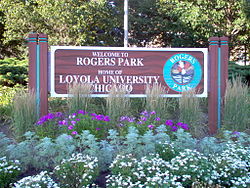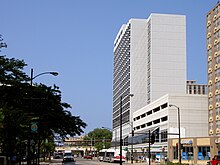Rogers Park, Chicago
This article possibly contains original research. (June 2008) |
Rogers Park | |
|---|---|
| Community Area 01 - Rogers Park | |
 Rogers Park, (Chicago, Illinois) | |
 Streetmap | |
 Location within the city of Chicago | |
| Country | United States |
| State | Illinois |
| County | Cook |
| City | Chicago |
| Neighborhoods | List
|
| Area | |
| • Total | 1.85 sq mi (4.79 km2) |
| Population (2000) | |
| • Total | 63,484 |
| • Density | 34,000/sq mi (13,000/km2) |
| Demographics | |
| • White | 31.8% |
| • Black | 29.6% |
| • Hispanic | 27.8% |
| • Asian | 6.40% |
| • Other | 4.48% |
| Time zone | UTC-6 (CST) |
| • Summer (DST) | UTC-5 (CDT) |
| ZIP Codes | 60626, 60645 |
| Median income | $31,602 |
| Source: U.S. Census, Record Information Services | |
Rogers Park is the northernmost of Chicago community areas in the far North Side of Chicago, Illinois, and is also the name of the Chicago neighborhood[1][2] that constitutes most of the community area. It is bounded by the city of Evanston along Juneway Terrace and Howard Street to the north, Ridge Boulevard to the west, Devon Avenue and the Edgewater neighborhood to the south, and Lake Michigan to the east. The neighborhood just to the west, West Ridge, was part of Rogers Park until the 1890's. Some Chicagoans use the phrase "East Rogers Park" to refer to any area east of Ridge, but usually East Rogers Park refers only to the portion of Rogers Park east of Clark Street.
Native American roots
The Rogers Park area was developed on what once was the convergence of two Native American trails, now known as Rogers Avenue and Ridge Boulevard, predating modern metropolitan Chicago. The Pottawatomi and various other regional tribes often settled in Rogers Park from season to season. The name of Indian Boundary Park in Rogers Park reflects this history as does Pottawattomie Park near Clark Street and Rogers Avenue.
Rogers Park was named after a pioneer settler and developer, Phillip Rogers. Rogers often traded and worked with the local tribes. Envisioning a future settlement, Rogers eventually purchased the land from the tribes for later development.
Becoming part of Chicago
From 1830 to 1850, waves of immigrants from Luxembourg and Germany came to Rogers Park, where farming was the main industry. The average price of land at the time was $1.25 an acre ($309/km²), and the dominant crops were hay, cucumbers for pickles, and onions[citation needed]. On April 29, 1878, Rogers Park was incorporated as a village of Illinois governed by six trustees. In 1893, the village was annexed to Chicago.[3] Successive generations brought about vast cultural changes to the former village. Elite Chicagoans began to move to new planned communities in the suburbs by the 1930s, which ushered in the migration of German, English, Irish, and Jewish families to Rogers Park. With the settlement of these migrants, their cultural traditions flourished[citation needed]. With the devastation in Europe following World War II, many additional immigrants found their way to Chicago and Rogers Park. Also, a growing and vibrant Hispanic community has grown along Clark Street.
Most of the neighborhood has for decades been within the 49th Ward of the city of Chicago, and the terms are sometimes used interchangeably, but, because of gerrymandering, parts of Rogers Park are now within the 48th and 40th wards as well.
Culture and cultural diversity
Rogers Park continued to see demographic changes into the 21st century. The 2000 census data, like those of 1980 and 1990, showed it to be one of the most diverse communities, if not the most diverse, in the entire country. A robust mix of ethnic backgrounds with over 80 assorted languages flavor the neighborhood. However, this diversity has been affected by gentrification of the community. Much of the rental housing that has been converted to condominiums since 2000 formerly housed racial- and ethnic-minority households. More than 90% of the new homeowners are white households, according to the Woodstock Institute, a nonprofit advocacy and research organization.[citation needed]. However, the financial crisis of 2007-2009 hit the area hard and at present many of the condominiums are unsold or foreclosed.[4] The dominant institution in Rogers Park is Loyola University Chicago. Historic places of interest include Madonna Della Strada Chapel, the mother church of the Jesuit Province of Chicago (one of the largest Jesuit provinces). The neighborhood continues to be home to many Jesuit religious-order institutions. However, modern Rogers Park contains many houses of prayer of different religions and denominations. An example of the neighborhoods' diversity is the historic Rogers Park Baptist Church.[5] Founded in 1891, this church has services in three languages every Sunday and is made up of immigrants from 21 countries representing 5 continents.
The presence of so many students and academics from Loyola, Mundelein College (now part of Loyola), and Northwestern University, just a few miles to the north, has historically lent Rogers Park a high degree of liberalism and tolerance. The community also has a high Internet presence. In 2007, the Web site outside.in named Rogers Park one of the country's "bloggiest neighborhoods."[6]
Beaches
Rogers Park is unique in that it is one of the few Chicago neighborhoods that has direct public access to Lake Michigan. Unlike other Chicago lakefront neighborhoods, nearly every east-west street in Rogers Park has a beach.[7] In addition, many buildings along Lake Michigan have their own private beaches.
Schools

- Chicago Math and Science Academy
- Chicago Waldorf School
- Field Elementary School
- Gale School
- Jordan Community Elementary School
- Hayt Elementary School
- Kilmer Elementary School
- Loyola University Chicago/Lake Shore Campus
- North Shore School
- PACTT Learning Center
- St. Margaret Mary School
- St. Scholastica Academy
- Sullivan High School
- Swift Elementary Specialty School
Transportation

Rogers Park has four elevated ("L") Red Line stations: Howard, Jarvis, Morse, and Loyola.[8] The Howard Street "L" station, the northernmost Chicago Transit Authority rail stop in the city proper, has experienced major renovation during 2008 and is a major transportation hub for the northern Chicago region. Both the Skokie Swift and the Purple Line (formerly known as the Evanston Express) begin in Rogers Park. In addition to the above, there are also several bus routes traveling to the Loop and the suburbs. They consist of the #22 (Clark to Polk), #97 (Old Orchard Shopping Mall/Cook County Courthouse), #147 (Outer Drive/Congress/Michigan Avenue), #151 (Sheridan Road) and #N201 (Central/Sherman in Evanston). The Metra commuter railroad Rogers Park station, at the intersection of Lunt and Ravenswood avenues, is centrally located in the Rogers Park neighborhood.
Community policing
In 1993, Rogers Park was selected as one of only five Chicago neighborhoods to implement a new concept for Chicago law enforcement: community policing, or CAPS. A merger of police and community efforts was implemented, which resulted in a noticeable effect on crime statistics. Weekly beat meetings (planning and strategy sessions) were held across the 24th Police District (Rogers Park). Within three years, after the success of CAPS in Rogers Park, all of Chicago's police districts had put CAPS into practice. "CAPS is the most ambitious and comprehensive community policing program in the country," said Susan M. Hartnett, project director and research associate at Northwestern University's Institute for Policy Research. "The success of the CAPS program in comparison to efforts in other big cities is attributable to Chicago's commitment to the program and the resources allocated to it. A unique CAPS feature that is also vital to the success of the program is the improved delivery of city services throughout the city.".[9]
Aldermanic Members of the Chicago City Council
Rogers Park lies mainly within the 49th Ward. There are minor ares that are within the 40th Ward.
| Name | Elected | Political Party | Position |
|---|---|---|---|
| Joe Moore | 1991 | Democrat | Alderman/49th Ward |
| Patrick O'Connor | 1983 | Democrat | Alderman/40th Ward |
References in popular culture
Rogers Park is the setting for Chicago-based singer-songwriter Michael Smith's song Ballad of Elizabeth Dark, recorded in studio on his 1993 release Time and recorded live on his 2003 release, Such Things Are Finely Done.
Notable Residents
- Edward Gorey (childhood)
- Phil Foglio, science-fiction graphic artist
- Shecky Greene (former Sullivan High School student)
- Elizabeth Bloomer, better-known as former first lady Betty Ford
- Lara Flynn Boyle (childhood)
- Dan Savage (childhood)
- Tina Fey (Early to mid 90's)[10]
References
- ^ "Chicago Neighborhood Map". Retrieved 2008-12-04.
- ^ "Chicago Neighborhood Maps and Neighborhood Guides". 2008. Retrieved 2008-12-04.
- ^ Patricia Mooney-Melvin. "Rogers Park". The Electronic Encyclopedia of Chicago. Chicago Historical Society. Retrieved 2008-12-15.
- ^ http://thislife.org/Radio_Episode.aspx?sched=1289
- ^ http://www.rogersparkbaptistchurch.org
- ^ "Inside America's Top 10 Bloggiest Neighborhoods". outside.in. 2007. Retrieved 2008-12-04.
- ^ E.g., http://www.chicagoparkdistrict.com/index.cfm/fuseaction/parks.detail/object_id/26DF5457-0D54-4BA0-9DE5-5957D226E9C9.cfm
- ^ RTA Trip Planner http://tripsweb.rtachicago.com/
- ^ Not in My Backyard - Northwestern study finds major concerns about crime motivates high citizen participation in Chicago's Community Policing Program.
Citizens of Chicago cited crime as 'the number one problem' facing the city and their own neighborhoods, and such concerns motivated a significant number of them to attend community policing beat meetings to solve neighborhood problems, according to a just released study from Northwestern University. Citizens affiliated with community organizations were particularly likely to have an impact on citizen participation in the policing partnership and on decision making, according to the findings.
{{cite book}}: Unknown parameter|origdate=ignored (|orig-date=suggested) (help); Unknown parameter|origmonth=ignored (help) - ^ http://www.believermag.com/issues/200311/?read=interview_fey
External links
- Official City of Chicago Rogers Park Community Map
- Rogers Park Historical Society
- Rogers Park Community Council
- Rogers Park Community Development Corporation
- History of Rogers Park on Encyclopedia of Chicago
- Lakeside Community Development Corporation
- DevCorp North
- Rogers Park Parents Group
- ForgottenChicago.com (little-known elements of Chicago’s infrastructure, architecture, neighborhoods and general cityscape, existing and historical)
- Rogers Park West Ridge Historical Society
